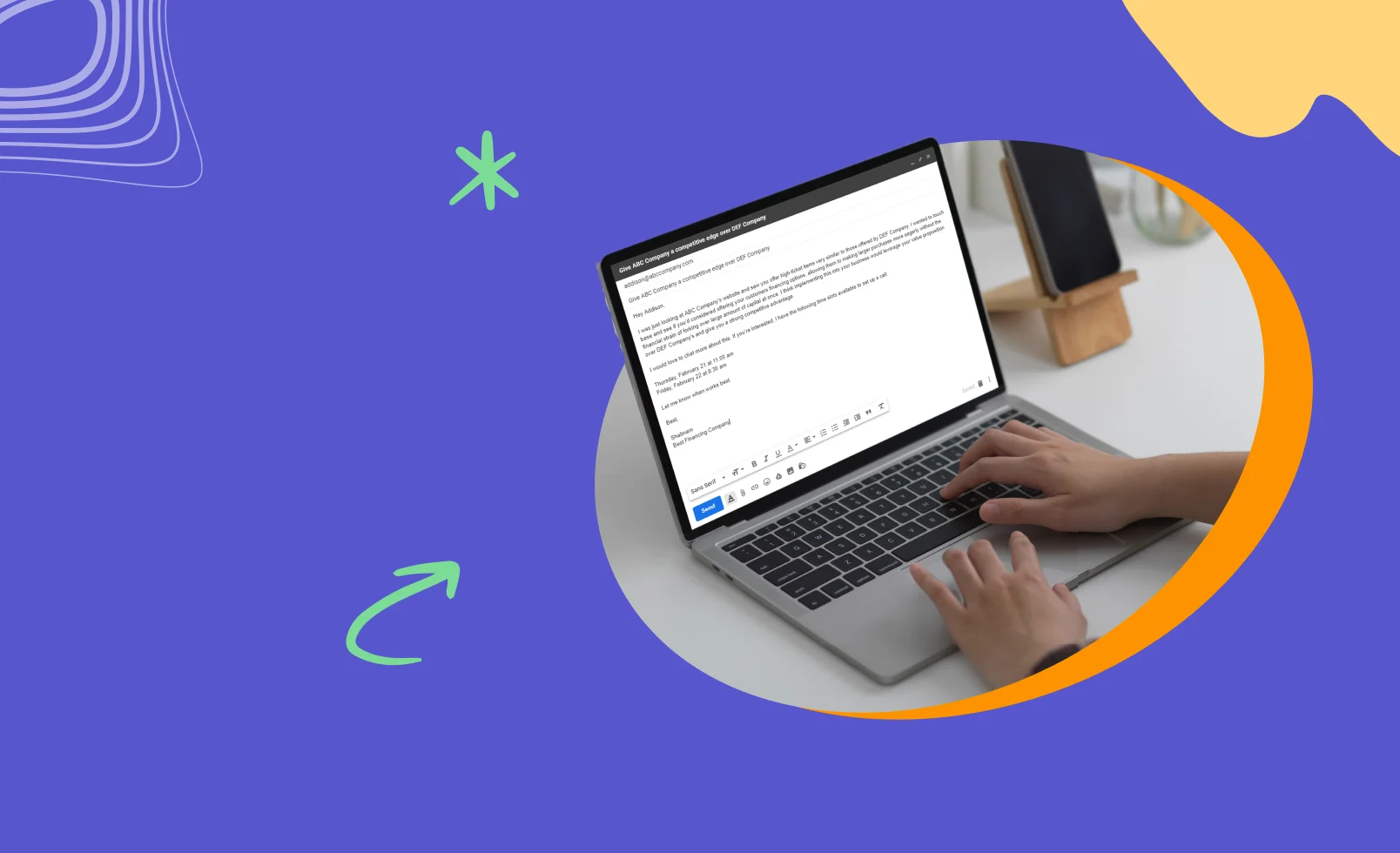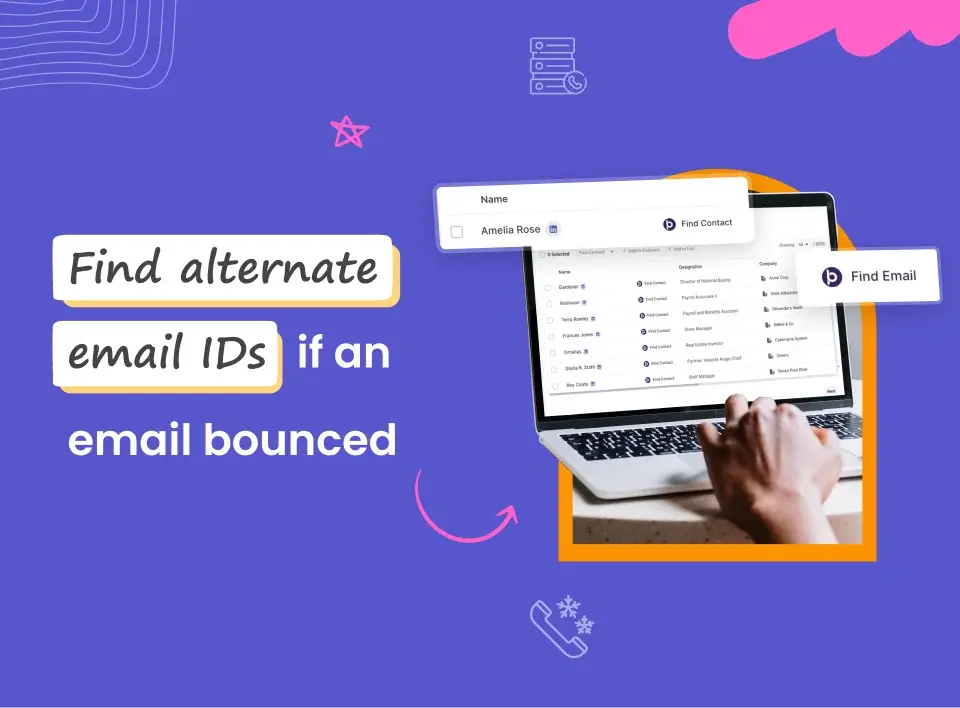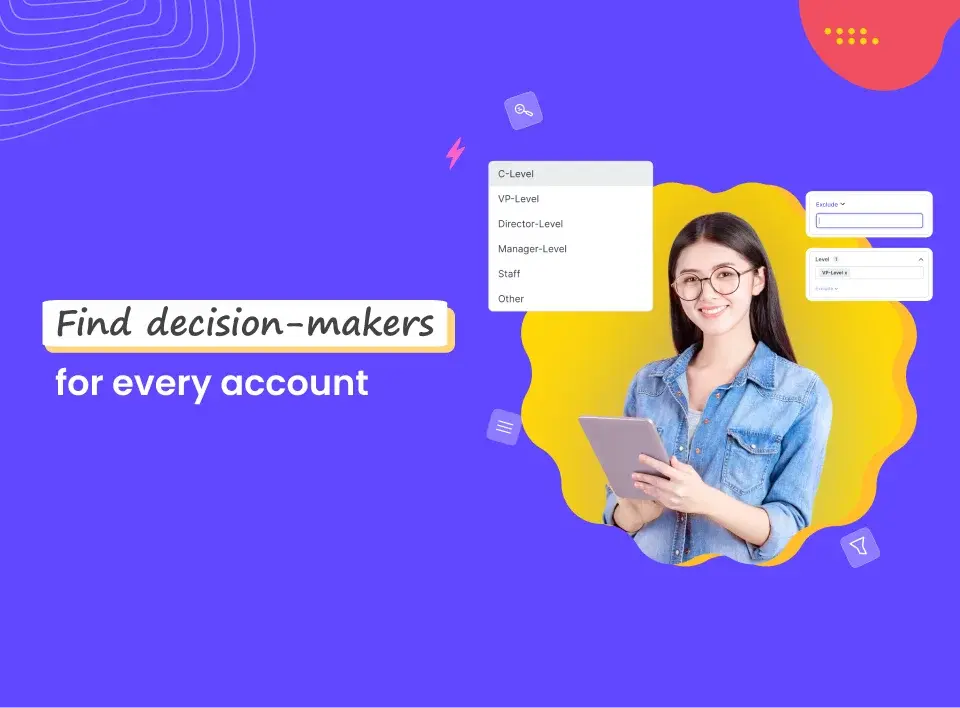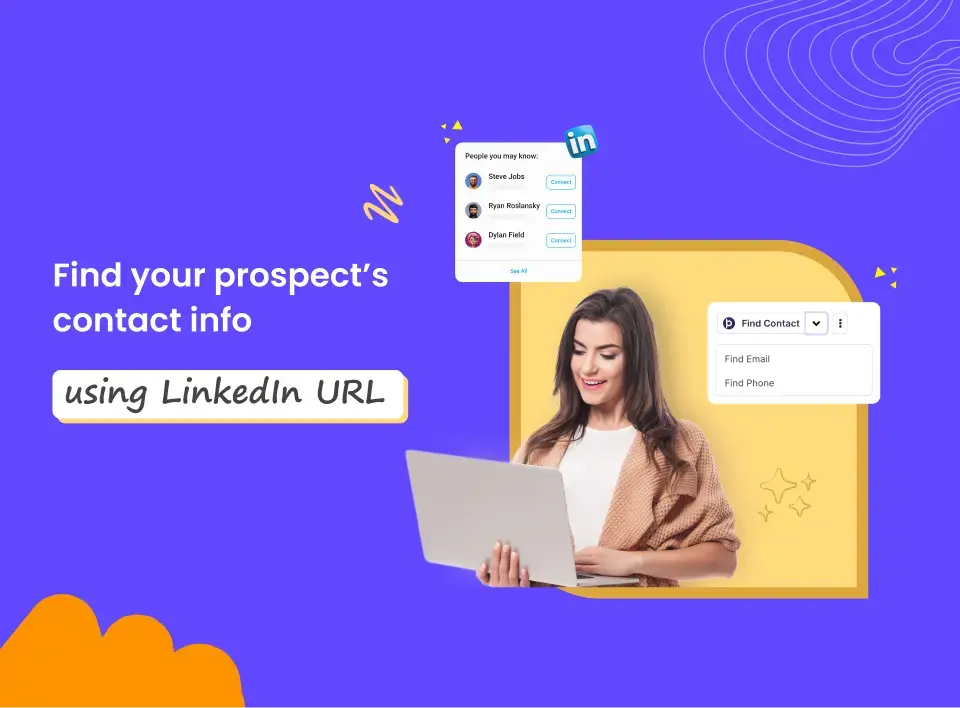“Email has an ability many channels don’t; creating valuable, personal touches at scale.” - David Newman, Marketing Coach & Author of Do It! Marketing
And we completely agree with that. Here’s more on the ROI of email as a channel:
The annual B2B survey by ChiefMarketer shows that email is the best channel to generate leads and also the best channel that produces the highest ROI leads.
Great. Ready to write that good old prospecting email?
But wait, here’s the hurdle. It’s not only you, but there are thousands of sales reps like you who are vying to get your prospect’s attention using emails.
Can you guess the number of emails your average prospect receives every day?
An email user on average gets 147 emails a day. And deletes nearly a half of them in under 5 minutes.
That’s not it. Only 24% of sales emails are ever opened. That means over 75% of prospecting emails get ignored!
Now, can you imagine how hard it would be to get them to open and respond to your prospecting email?
Clearly, the challenge with email prospecting is not whether it works as a channel, but whether you can make your emails stand out in your prospect’s inbox and get them to respond.
And in this post, we share 12 practical techniques and tips to help you get the most out of your email prospecting campaigns.
But first, let’s start with some basics.
What Is Email Prospecting?
Email Prospecting is the act of reaching out via email to potential customers (prospects) with the aim to make a connection and convert them into your customers.
Why Is Email Prospecting So Popular?
Here are the reasons why so many companies use email prospecting to generate leads.
1. Predictable Revenue Growth
Email prospecting is easily the most predictable revenue growth channel for your business. Compared with other channels like inbound, blogging, SEO etc, when it comes to email prospecting, the minute you establish a working process and model, it is very easy to add more fuel to the fire and establish a predictable lead generation engine.
2. More Targeted
Email as a channel is more targeted as it gives you more control over who you reach out to and with what message.
3. Easily Measured and Optimized
It allows for understanding the performance of your prospecting emails better. It's quite effortless to see where you're going wrong with your campaigns.
With an email automation platform (like Klenty), you can easily automate, track and evaluate your prospecting emails. And iterate to improve your campaign results.
4. Less Interrupting and Annoying
Compared with other channels like cold calling, emails are less interrupting and annoying. There is no pressure to respond on the spot. Your prospect can read your email, ruminate whether it makes sense and get back to you on their own time.
“Email is non-threatening – they can reply when they want to, they don’t have to have a conversation on the spot. Email gives the customer more freedom.” - Scott Mark, Partner at InsideSales
5. Personalized
With emails, you can truly make it personal. Compared to other channels like Ads, which are generic broadcasts, each email can be written for an audience of one - with the exact messaging that makes sense for their business.
6. High ROI
An obvious advantage of email prospecting is its lower cost, though, there might be a little overhead when sending thousands of emails, but the costs far outweigh the costs you would incur using other sales channels.
With an email automation tool, you can send out prospecting emails to hundreds or thousands of prospects with just a single click and set up automated follow-ups based replies, link clicks, etc.
That’s why email prospecting is a core part of any sales strategy. Now the question is, is it right for you?
Is Cold Email Prospecting Right for Your Business?
Email prospecting is a widely used sales channel. And it works.
But there's a problem, though. Just because everyone's doing it doesn't mean that it's right for your business.
One way to tell if your business could benefit from email prospecting is by considering your product's price point and the total number of potential customers who are a great fit for your product right now.
At a very low price point - say you are selling a $10 product which could be sold to millions of customers, a more mass-market channel like SEO or paid advertising would be an appropriate channel.
Email prospecting works like a charm when you have a very clear definition of who your target customer is and have a way to build a very relevant list of such prospects.
This infographic provides a spectrum of channels available - depending on the price-point of your product and your ability to identify your end customer.
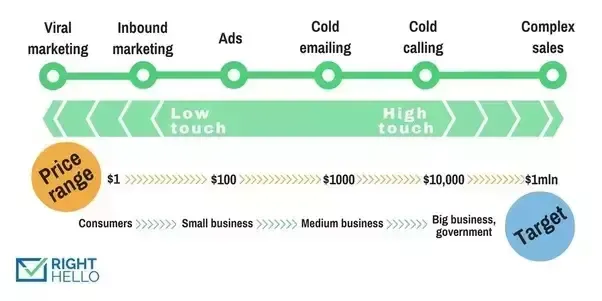
Now that you know what it is and whether your business would benefit from using it, let’s get knee deep into some powerful techniques to crack your email prospecting game.
Simplify Email Prospecting with AI SDRs
All These Techniques Work—But at What Cost?
These techniques undoubtedly help you craft the best cold emails and increase the chances of getting a response. But think about the time and effort it takes to personalize, research, and execute each email for every single prospect. The process can feel overwhelming, especially when response rates don't match the effort put in.
This is where an AI SDR steps in.
AI SDRs like SDRx handles all the heavy lifting—research, personalization, follow-ups, and even crafting the email itself.
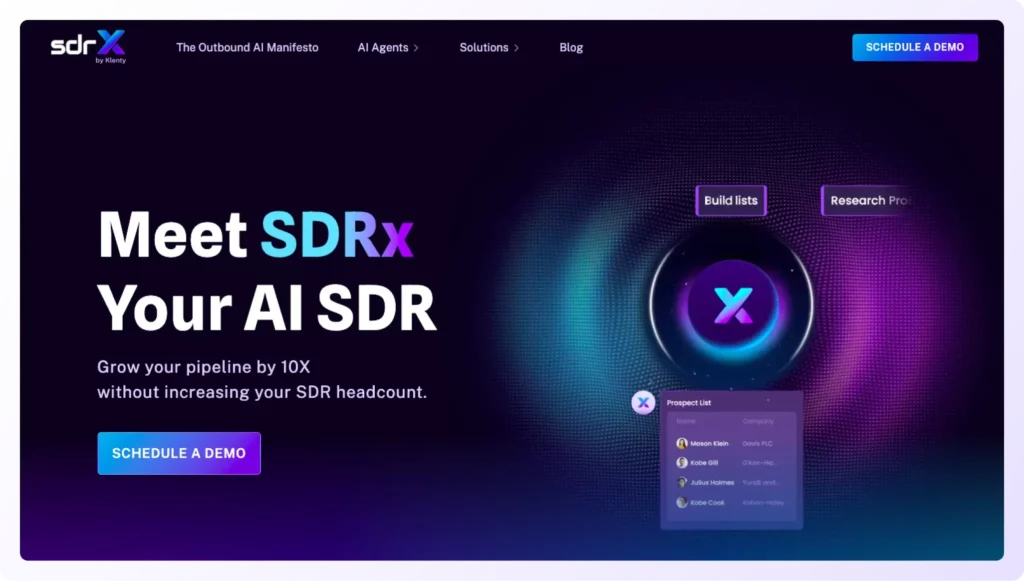
With SDRx, you can launch your outbound campaigns in the best way possible, without draining hours on manual tasks.
The result? A list of engaged leads ready to close deals, leaving you to focus on what truly matters—selling.
With SDRx, you can launch highly targeted outbound campaigns effortlessly and get a list of engaged leads ready to close deals. All the effort you’d spend on prospecting is now streamlined into minutes by your outbound AI SDR.

12 Powerful Techniques To Write a Sales Prospecting Email
Research Your Prospects
Researching your prospects helps you with two crucial things:
- Validate if the prospect fits your Ideal Customer Profile
- Personalize your prospecting email
It’s crucial to get the former right. There’s no point in contacting someone who doesn’t have a need for your solution. By sending them a prospecting email, you might end up annoying them and get your emails marked as spam.
So the first step to being successful at your email prospecting game is to know who your ideal customers are. These are prospects that are ideal for your business and are highly likely to buy from you.
In order to make sure the company fits your ideal customer profile, research on some basic attributes about the company, like:
- Company Size(annual revenue, number of customers, number of employees)
- Geographic Location
- Industry - market category or niche they serve
- Age of Company(how long they’ve been in business)
- Product Offerings
- Typical Sale Size
Now that you know this business fits your ICP, what next?
You need to find the right person to reach out to in this company. You need to know about the individual/job role in that company responsible for making buying decisions that align with what you're selling.
Make this individual your subject of research. The information you need to collect on this person depends on the kind of company he works for. The larger the size of the company, the larger the deal size. The larger the deal size, the more personalized your prospecting email should be.
For companies with small deal size, spend lesser time by collecting some basic information on them as basic personalization would suffice in this case.
For companies with large deal size, spend more time collecting more information on them as it pays to make your prospecting email more personalized.
Personalization Is Key
The importance of personalization cannot be emphasized enough. Most prospecting emails get a poor response largely because they lack personalization.
Most of them are templated emails that sound cliché and salesy. People are put off by mass-produced emails that have no regard for their specific concerns and needs.
You need to add a personal touch that conveys your care for them as individuals. Adding this personal touch could make a world of difference for your email outreach campaigns.
A study by the University of Texas found that personalized content gave people a sense of control and made them feel special and unique. For this reason, personalized content drives consumers to make a purchase.
As a matter of fact, personalized emailing was the most effective email strategy of 2017.
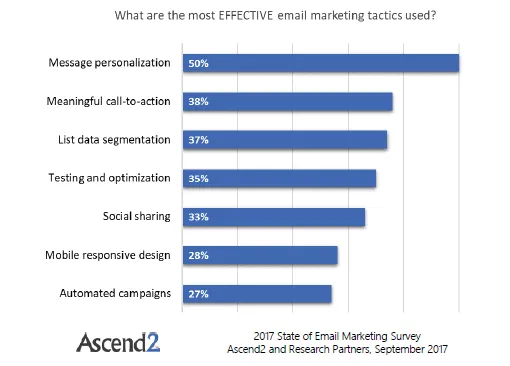
Furthermore, a personalized email improves click-through rates by 14% and conversion rates by 10%.
So how should you go about personalizing your prospecting email?
Well, the level of personalization you should achieve with your prospecting email is subjective and depends on the number of prospects you need to contact.
If you are targeting a very small number of highly relevant prospects, then you can afford to get really personalized. It depends on the deal size. The higher the deal size, the more personalized a prospecting email should be.
At the bare minimum, add some basic personalization such as:
- First Name
- Last Name
- Position/Title
- Company Name
Here’s what a template that employs basic personalization looks like,
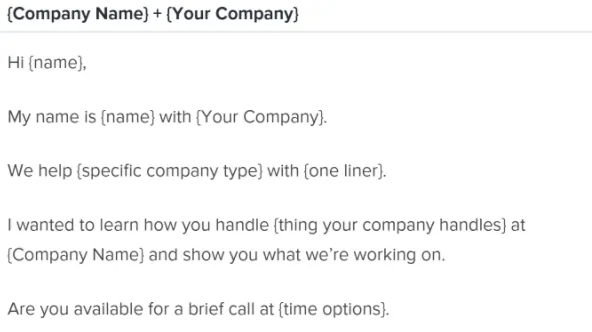
For prospects where the potential deal size could be substantial, connect deeper with them using some of these techniques:
- Coworker/Colleague Name
- Competitor Name
- Demographic Information
- Niche/Industry Data
- Personal/Professional Interests
- Alma Mater
- Recently Published Content Piece(& Why you liked it)
- Recent Business Challenges/Pain Points expressed
- Recent Awards/Recognitions
Here’s an example of a template that employs advanced personalization (Personal Interests):
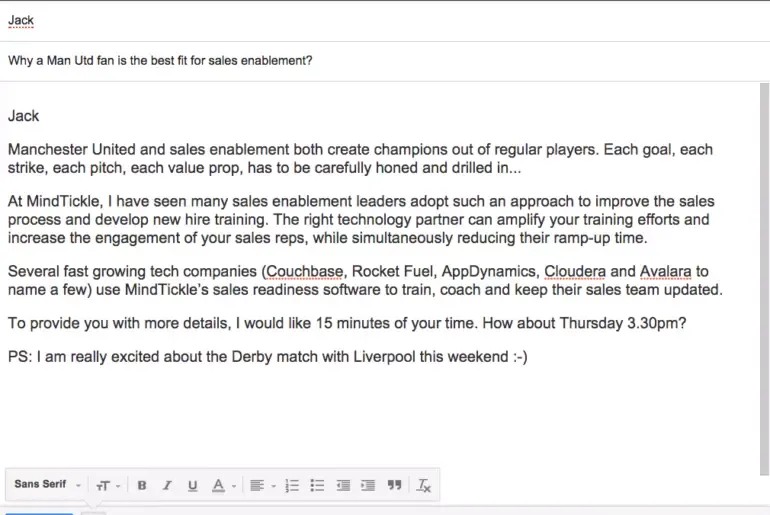
Use an Engaging Subject Line
To have a chance for your email to get read, it needs to be opened in the first place.
How do you get your prospects to open your email?
The answer is an engaging subject line.
Your subject line is the key component that decides whether your email is going to get opened or not.
A subject line is to an email what a title is to a blog post. If it isn’t catchy and relevant, your email is going to end up in the trash.
“If your subject line fails to get the recipient to open the email, everything else you do doesn’t matter.” - Steli Efti, Close.io
35% of recipients open emails based on the subject line alone. So it’s essential that you make it count.
Here are a few key things to keep in mind when it comes to prospecting email subject lines,
- Include the first name of the recipient in the subject line. Emails that include the first name of the recipient in their subject line receive higher click-through rate than the emails that don't.
- Keep your subject lines short and sweet. Keep them under 50 characters. You can tell the story later. Short and attention-grabbing subject lines typically receive more replies.
- Use a subject line checker tool to rate your subject line’s ability to result in open rates. Here’s a list of best subject line tester tools to boost your email opens.
- Avoid using spammy subject lines like BUY NOW! DON’T MISS THIS GREAT OFFER!
- Ask a compelling question. For instance, you might want to try the following: “Are you making these follow-up mistakes?” or “Is big data killing your sales campaign?".
Looking for some inspiration to write your next killer subject line? Here’s a list of 50 best subject lines for prospecting emails proven to skyrocket open rates.
Keep It Short
Writing too much is a common mistake salespeople make when it comes to sales prospecting emails.
Would you take the time to read a long, boring email from a total stranger?
Me neither.
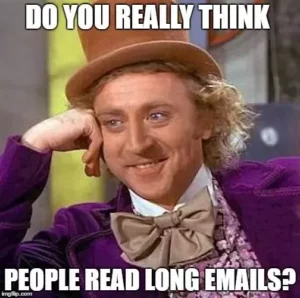
The primary goal of your prospecting email is to elicit a response. The shorter the message, the faster it will get read and responded to.
Keeping your message short is a great way to let your prospects know that you value their time. This way, they’ll be more willing to hear out what you have to say.
An analysis of more than 40 million emails discovered that people more often respond to shorter emails.
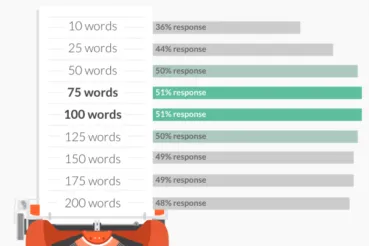
From the above study, it’s evident that in order to get the highest rate of response, your prospecting email should be under 125 words but not lesser than 50 words.
Focus on Benefits
People don’t want to hear about you or your company or your product’s features; especially when it’s from a total stranger trying to sell them something. They want to hear about how you are going to help them add value to their business. Period.
Your focus should be on making them realize how they would benefit from your using your product/service. Because prospects don’t care about what your product can do but what they would get out of it.
For example, instead of saying ‘a hosting software that can handle multiple core structures of data’, you need to say ‘you can be confident your site won’t go down when your latest product offering goes viral’.
“People have little interest in purchasing a bed. What they want is a good night's sleep.” - Gregory Ciotti, Helpscout
State a key benefit your prospect would derive from your product or a specific pain point they would want to be solved.
In the following example, a sender tweaks his initial email that receives a poor response rate and makes the value the prospect would get from the product clear by highlighting a use case that’s specific to the prospect’s industry and the benefit they would derive from it.
The tweaked version of the email increased the response rate by 1400%.
The first email that talks about the features:
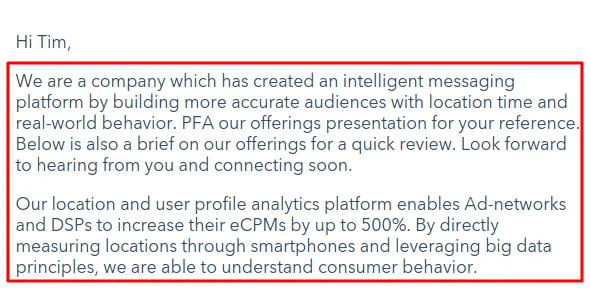
The Response Rate for this email - 1%
The tweaked second email with the benefits:
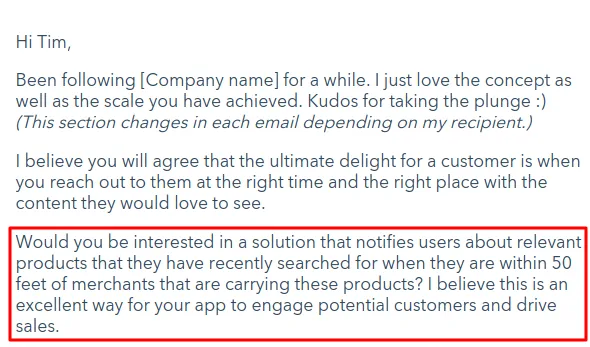
The Response Rate increase for this email - 1400%
Provide Social Proof
Social proof is an extremely powerful ingredient to influence the actions of people around us. Over 85% of consumers trust reviews as much as personal recommendations, and 73% of them say positive customer reviews make them trust a business more.
Even more, is the fact that social proof can increase response rates of prospecting emails by up to 468%.
Why does social proof work?
Well, it has to do with how a human’s brain functions. The brain makes decisions by looking for cues (or signals). The strongest of the cues is to see what others are doing. Hence, the brain makes decisions by taking cues from fellow human beings.
Simply put, our brains are wired to go with the crowd.
According to a recent study conducted on air passengers, 70% of the passengers were more likely to order a meal if their neighbor ordered one.
One way to go about building social proof is to reference your most famous customers or include a case study that aligns with the challenges and pain points of your prospect.
A research conducted by Hiplead found that mentioning a famous customer in a sales email increased the conversions by 208%.
To get an idea on how you could add famous customers into your email, take a look at one of our follow up templates.
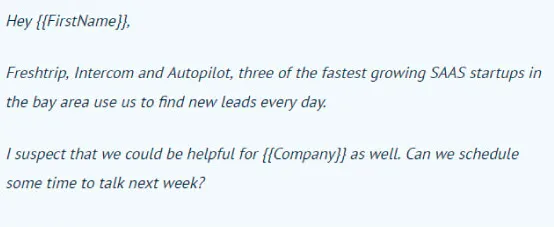
You could also include a case study to leverage the power of social proof. Here’s a sample template to get you started.
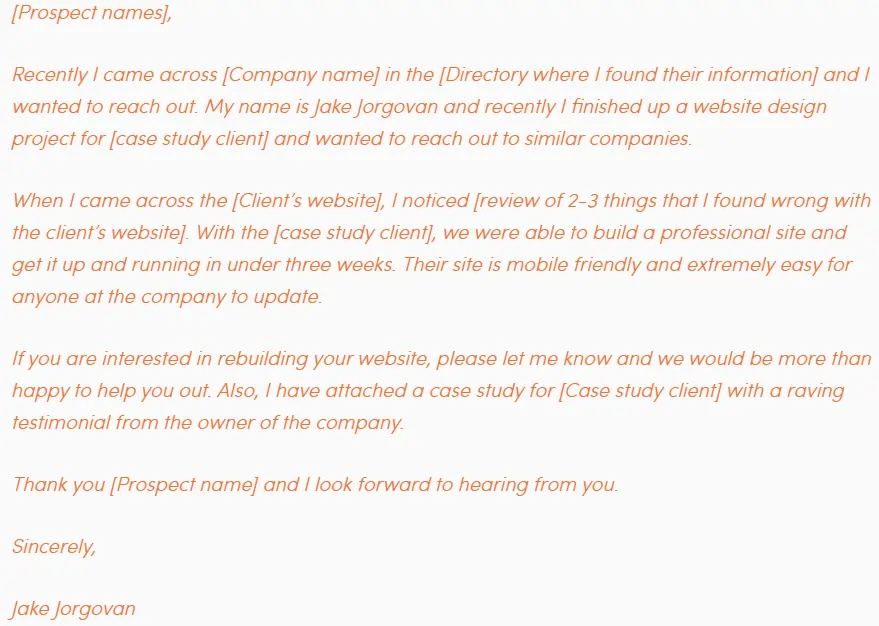
Include a Signature
An email signature serves as your company’s electronic business card. It makes your prospecting email seem more professional and helps you address the legal concerns regarding your prospecting email by being compliant with the CAN-SPAM act.
Furthermore, it provides your recipients with additional options to contact you, other than only through a reply email.
A basic email signature should at least contain:
- Name
- Current position/Title
- Company website link
- Phone number
Here’s what a basic email signature would look like:
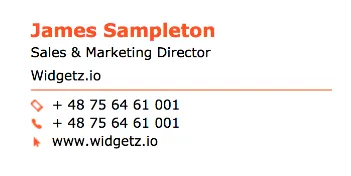
One way to use your email signature as an effective way to engage your prospects is to include a call-to-action in it.
Anyone who has made it to the end of the email has already demonstrated an interest in learning more about you and your company. You need to stoke this interest and help them take the next step by adding a call-to-action in your email signature.
Having a call-to-action in your email signature can:
- Reiterate the action you want them to take.
- Drive traffic to your site and social profiles.
- Help promote a specific piece of content(like a blog post, lead magnet, etc.).
- Direct recipients to schedule a demo, register for an upcoming product launch or webinar, enter a contest, take a poll etc.
Here’s an example of an email signature that has a call-to-action to get prospects to book meetings.

Here’s another example of an email signature that has a call-to-action to help drive traffic to a blog.

One thing to remember when adding call-to-action to your email signature is to refrain from adding too many calls to action.

For more ideas on crafting an effective prospecting email signature, see our article on the three key components that make an effective cold email signature.
Be Clear on Your Email’s Purpose
Does your prospecting email have a purpose? You should write your prospecting emails with a clear purpose in mind.
You need to be very precise about what you need and what you expect your prospects to do.
Do you want them to sign up for a demo? Do you want them to download a useful resource?
For instance, do you want your prospects to arrange a meeting with you?
Look at how the below template cuts to the chase and clearly asks prospects to book a meeting.
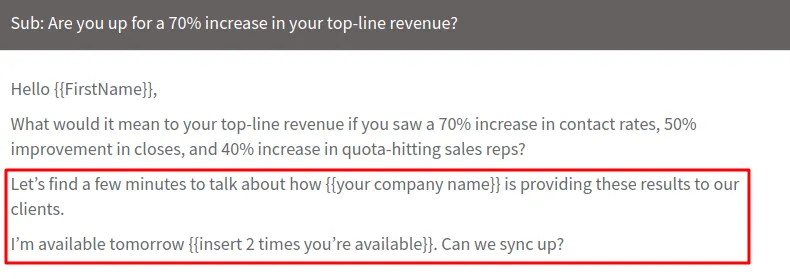
Let the prospects clearly know what you expect from them. Tackle the main concern of your prospect and ask for a response.
A research by psychologist Robert Sutton says that people are more willing to help when provided with clear directions.
You will fail to get a response if you ask your prospect to dictate the next step.
So don’t leave your prospects guessing about what you need. Include a clear and compelling call-to-action.
Provide One and Only One Clear Call-To-Action
Use only one clear and compelling call-to-action.
By having multiple calls to action, you end up overwhelming them by asking them to take too many decisions at once; which, in most cases, results in inaction.

Decide on the one thing you want your recipient to do and make it stupidly simple for them to do it. The more mental energy it takes to perform an action, the less likely they’re to take that action.
A recent statistic shows that emails with a single call-to-action increased clicks 371% and sales 1617%.
So steer clear of cramming your emails with multiple calls to action and use only one CTA.
Bonus resource: Want to craft compelling calls to action for your prospecting email? We've laid out 10 powerful techniques to nail the call to action for your prospecting email.
Time It Right
Sending your emails at the right time can have a disproportionate impact on your email opens and responses.
So, what’s the best day and time to send your emails?
The answer to that lies in this question.
When do your prospects typically open your prospecting emails?
In order to get your timing right, you need to focus on your prospect’s behavior.
Align your sending time with the time your prospects are most likely to open the emails. You can use our email tracking software to find out when your emails were opened and whether your emails were opened, forwarded, or ignored.
From there, adjust your timing and sequence based on your findings.
Follow Up Effectively
There’s a huge reason why prospecting emails don’t generate enough leads. And it has nothing to do with the prospecting email itself.
Surprisingly, it’s because most salespeople give up right after sending the first email and don’t follow up. Or, at least, that’s what the statistics indicate.
Statistics show that 70% of unanswered email chains reportedly stop after a single email. Only a mere 19% send a second email.
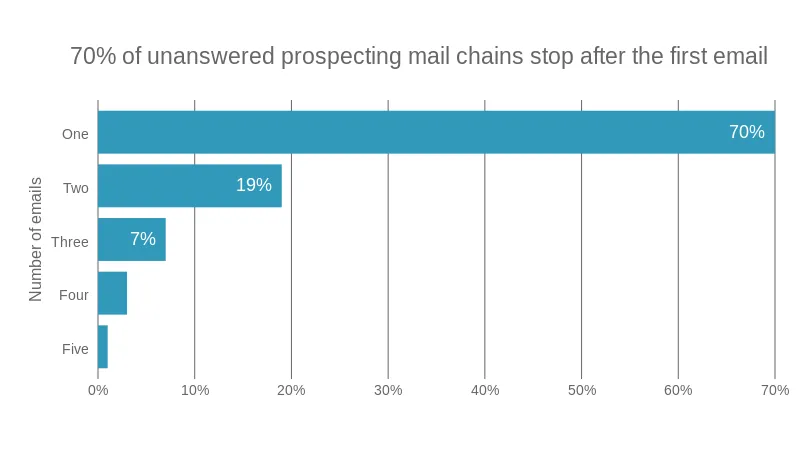
Yet, follow-up emails typically receive higher response rates than the initial email.
A study conducted by Iko System saw a reply rate of 18% on the first email, 14% on the second, 13% on the fourth, and a massive 27% on the sixth. Totally they sent 7 emails and found that even the last email received a response rate of 17%.
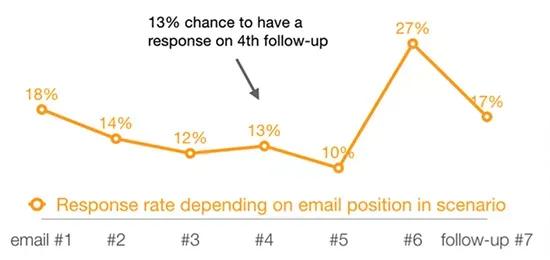
Moral: Sending follow up emails is essential. You need to be persistent in your follow-ups and shouldn’t give up too soon.
Want to know how to follow up effectively with the prospects? Our comprehensive guide on how to write a follow up email will provide all the answers.
A/B Testing
When it comes to building an effective email prospecting strategy, taking a cue from industry benchmarks only takes you so far. The best practices should be seen no more than as guidelines.
In order to find what truly works for your company and prospects, you need to try different approaches and see what works for you.
What do you do to make sure a prospecting email is as effective as it could be?
Enter A/B testing.
A/B or Split Testing is an experiment where two versions of a landing page, email subject line or CTA are shown to the target market to determine which version performs better or converts the best.
How does A/B testing work? The process of A/B testing is quite straightforward and involves the following steps:
- Decide on the one element you would like to test(For instance, an email subject line).
- Prepare the two alternate versions of this element(For instance, subject line A and subject line B).
- Based on the element, decide on the criteria for your winning variant(For instance, if the element’s a subject line, then the criteria would be the mail’s open rate).
- Decide on the length of your A/B test.
- Split your target audience into two halves.
- One half is shown with variant A while the other half is shown with variant B.
- Compare the two variants for significant differences.
- According to your findings, keep the version that worked better.
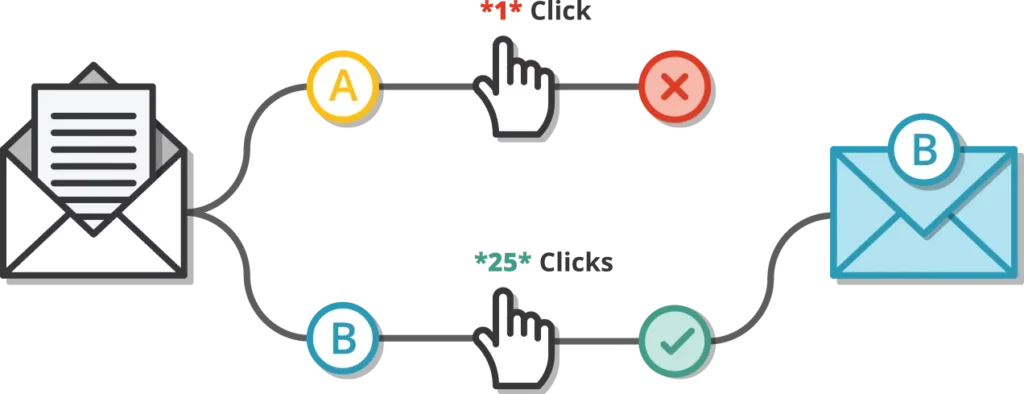
What should you be testing? You need to test the following crucial elements,
- From Line
- Subject line
- Introduction
- CTA(Call to action)
- Value Proposition/Pitch
- Signature
- Best Day and Time to send emails
You need to continually tweak, test and measure each element above to get the best possible open and response rate.
For an expert view on A/B testing, check out our Cold Email A/B Testing Playbook.
Conclusion
Email prospecting works and is an effective outbound marketing technique. Entire businesses worth hundreds of millions have been created using email prospecting as the dominant lead generation channel.
However, it needs to be approached with a well-informed strategy.
Once you iterate and get the process working, it can transform your business into a predictable lead generation machine.
